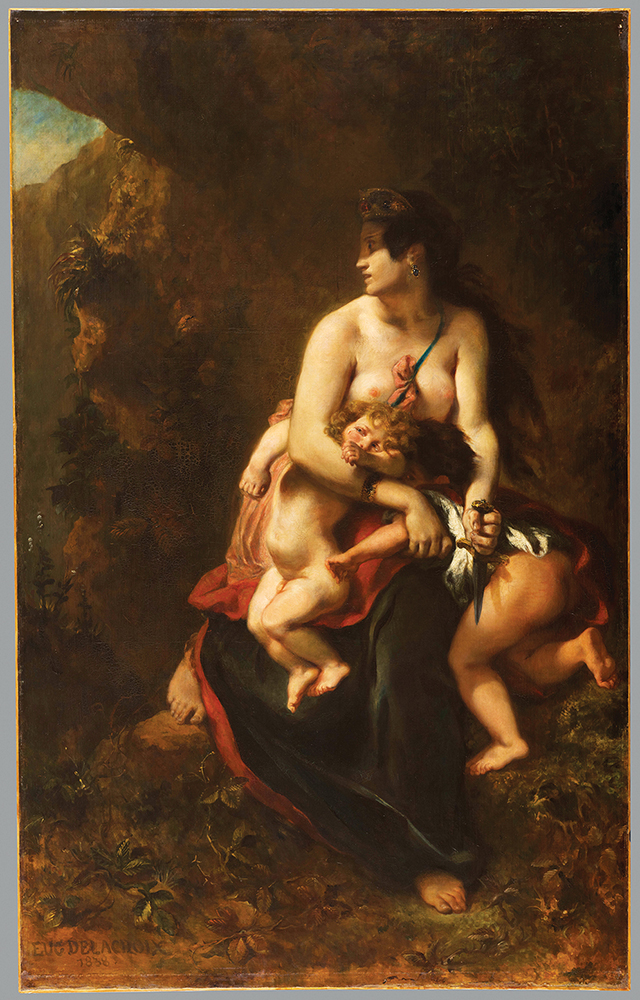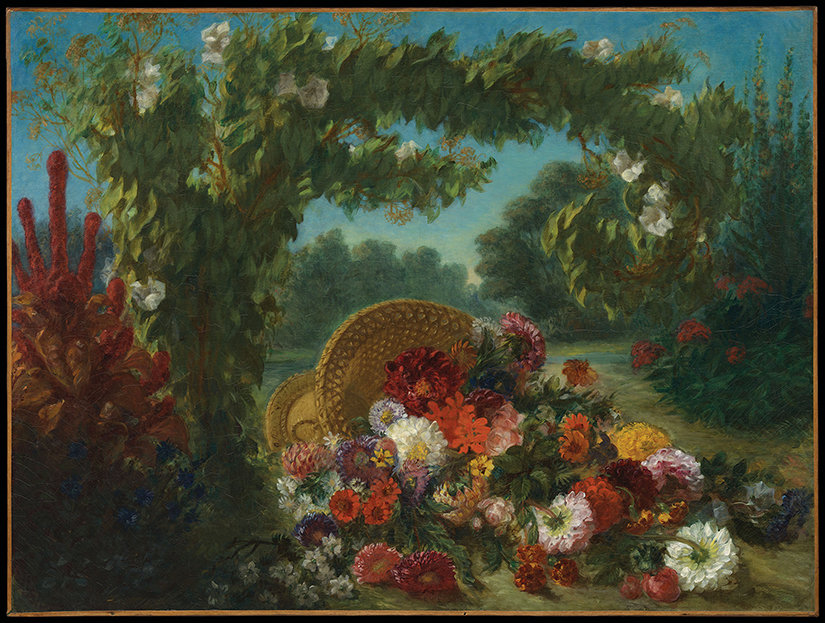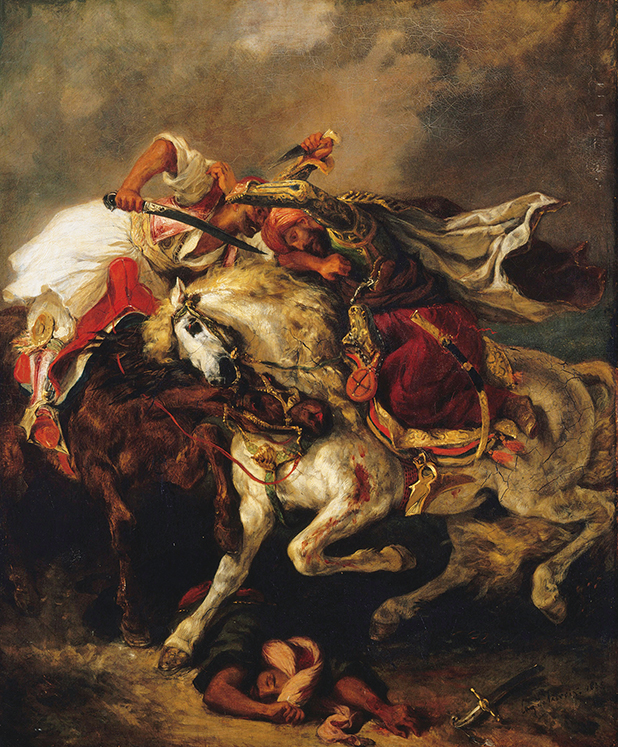Delacroix
Writer John Zeaman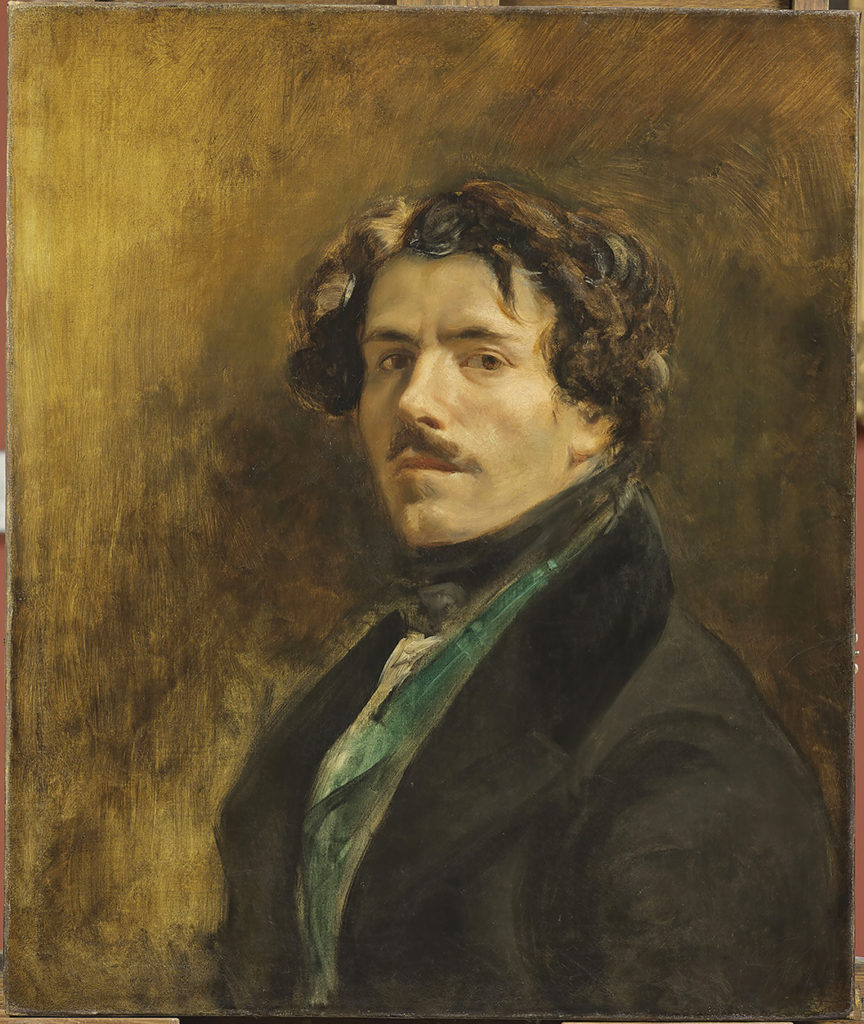
Self-Portrait with Green Vest, ca. 1837. Oil on canvas. Musée du Lourve, Paris.
European master gets his first major North American retrospective
If you’re interested in the art of painting and want to spend some time with one of history’s greatest practitioners, you should see “Delacroix” at New York’s Metropolitan Museum of Art. The show, which is open through the holiday season (closing January 6), is a rare opportunity to get to know one of the masters of narrative and expressive art.
Why rare? If you’ve ever visited Paris as an art tourist, Delacroix is omnipresent—he’s at The Louvre and other museums, in churches and public buildings, and in the studio (now a museum) he occupied on Rue Furstenberg. But in this country, not so much. Unlike many other 19th century European masters, he’s never been the subject of a major retrospective in North America.
Now at last, a great banner featuring his dashing self-portrait billows over the Met’s Fifth Avenue entrance. Inside, are 12 galleries displaying some 150 paintings, prints, drawings and manuscripts on loan from some 60 museums and private collections around the world.
Who was Delacroix?
Eugène Delacroix was born in 1798, toward the end of the French Revolutionary Wars. He grew up during the reign of Napoleon. Two of his brothers, much older, fought in the Napoleonic Wars. One rose to the rank of general, the other was killed in battle in 1807. His father, Charles-Francois, was a French statesman, but it’s long been believed that his true father was the famous foreign minister and family friend Maurice de Talleyrand.
By 1814, the 16-year-old Eugène was an orphan—and due to chicanery by a family lawyer—utterly destitute. He was determined to make a name for himself and to restore luster to his family name.
His early artistic training was in the neoclassical style of Jacques-Louis David, whose hard-edged, carefully balanced paintings glorified the purity of Greek and Roman art. Delacroix, however, was moving in a different direction. Instead of firmly outlined and carefully controlled brushstrokes, he developed a style that was painterly, vibrantly colored and passionate. And instead of painting the stoicism and heroism of Spartan soldiers, he drew on more romantic sources—poetry by Dante and Lord Byron, novels by Sir Walter Scott, Shakespeare’s plays and Wagnerian operas.
He was unknown when he made a hit with his first work to the 1822 Paris salon, The Barque of Dante (Dante and Virgil in the Underworld). It depicts a nightmarish scene from The Inferno. The poet and his guide try to cross the River Styx while damned souls—like characters from a zombie movie—clutch at the boat, gnaw on its gunnels and try to claw their way aboard.
Not everyone was enamored of the picture. One influential critic called it “a daub,” which, to contemporary ears, might sound like an odd criticism for such a violent image. But the comment was aimed at the expressive brushwork, at odds with neoclassical standards. Most importantly, it was acquired by the national Musée du Luxembourg (guaranteeing it would eventually pass into the collection of the Louvre, a great honor for a 24-year-old artist).
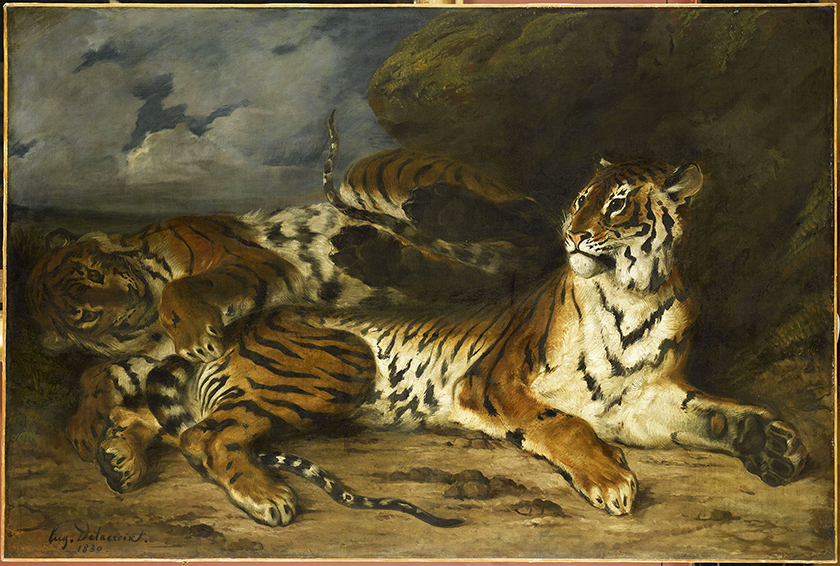
Young Tiger Playing with Its Mother, 1830. Oil on canvas. Musée du Louvre, Paris. © RMN-Grand Palais (Musée du Louvre)/Franck Raux
Delacroix had arrived. “Fame is not an empty word for me,” he wrote to a friend. “The sound of praise gives me real happiness.” And so it went for the rest of his career. Over four decades, he continued to take risks and to put his reputation on the line by submitting to the salon every year.
Today, Delacroix’s art is the essence of romanticism. His art embraces high emotion, tragedy, the exotic and sometimes just pure excitement. Most importantly, he didn’t rely simply on illustrational means, rather he tried to convey a story’s emotions through the visual language.
“When I have done a fine painting, I have not expressed any thoughts,” he wrote on a journal page displayed in the exhibit. “A writer says almost everything in order to be understood; painting builds a kind of mysterious bridge between the soul of the characters and that of the spectator.”
Among his most tumultuous paintings was The Death of Sardanapalus, based on the story of an ancient king, who, facing imminent defeat by his enemies, has all of his most precious possessions destroyed—including women, slaves and animals. Delacroix whips up a frenzy of violence and cruelty. Women are eviscerated or flogged with torches. Wild-eyed horses are dragged into the picture frame while being stabbed. The dead and dying are strewn about. And there, at the center of it all, reclines the despot himself, watching with what looks more like boredom than despair.
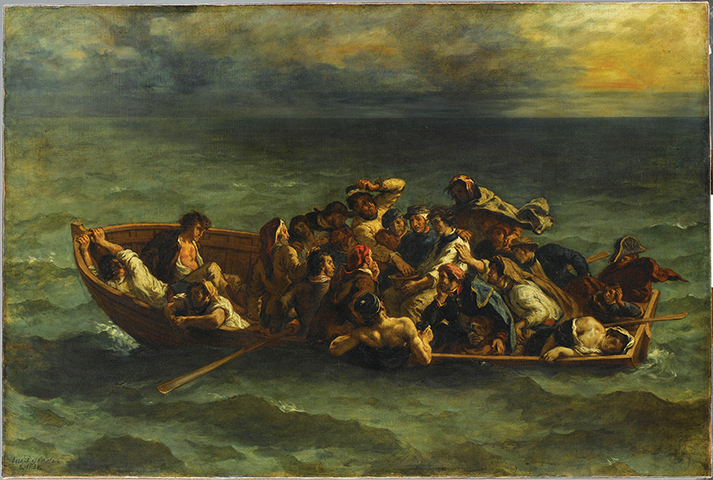
The Shipwreck of Don Juan, 1840. Oil on canvas. Musée du Louvre, Paris, Gift of Adolphe Moreau, 1883. © RMN-Grand Palais /Art Resource, NY. Photo by Gerard Blot
But Delacroix was no mere sensationalizer. In one of his greatest paintings, Medea About to Kill Her Children, he turned to a difficult theme from the Greek tragedy by Euripides. Medea, abandoned by the hero, Jason, takes revenge by murdering their two children. If you go to this show, be sure to spend some time in front of this painting. The canvas is 81⁄2 feet tall, and you look up at the scorned woman as at a monumental statue. The murder itself is not depicted but is imminent. Medea crouches nude in the mouth of a cave, gripping her squirming offspring and a glittering knife. She peers guiltily over her shoulder toward the light as if expecting to be discovered. A shadow cuts across her brow as if to evoke the rage that has driven her mad.
At times like this, Delacroix can seem like a brilliant movie director. He knew what held people’s attention. He knew how to orchestrate drama and action scenes. There might be a few too many galloping horses and pouncing tigers in this show. But the painterly technique often transcends the subject matter. In Combat of the Giaour and Hassan, two entwined riders look on the verge of simultaneously killing each other. Blur your eyes just a little, however, and it becomes a swirling abstraction, a pure evocation of gut-wrenching emotion.
Delacroix could endow horses with a grace and sensitivity that sometimes elicits more empathy than his human characters. One of the sweetest, most poetic pictures here is a late painting titled Ovid Among the Scythians. It refers to the Roman poet’s banishment by Emperor Augustus to the banks of the Black Sea. In Delacroix’s imagining of it, Ovid sprawls childlike on the ground, helpless in this new environment, while a barbarian family offers him gifts and food, including mare’s milk. The horse—the real star of the painting—is a chestnut beauty with a flowing black mane who stands straight and tall in the rippling breeze while the milk is drawn.
There’s no arguing that Delacroix’s romanticism could be a bit juvenile, akin to boys’ adventure stories. He loved painting lions and tigers, for example. The show’s very last painting, the wild Lion Hunt (Fragment), in which lions plant their massive claws into men’s flesh, might be over the top, but you can’t take your eyes off it. His Young Tiger Playing with its Mother, is mesmerizing, a masterpiece of animal observation.
Many of the nudes flirt with erotica. They look like they were commissioned by men to decorate a den. The abduction of women by men on horseback is the sort of subject that looks like forbidden territory today. But others are charming, even humorous. One, based on a ribald tale, tells of a duke who is having an affair with another man’s wife. The duke boasts so much about her beauty that he is pressed—by the husband, himself!—for a look at his mysterious mistress. The duke complies, but in hopes of avoiding discovery, only lifts the veil on the reclining woman’s lower half. The foolish husband smiles approvingly but fails to recognize his own wife.
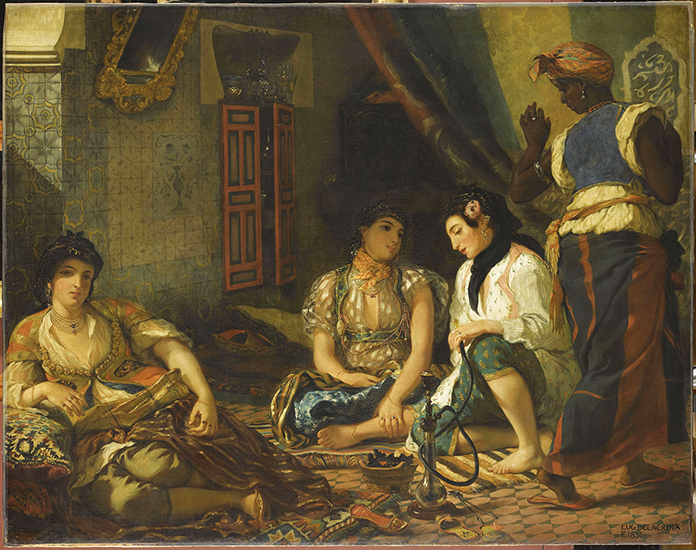
Women of Algiers in Their Apartment, 1834. Oil on canvas. Musée du Louvre, Paris. © RMN-Grand Palais/Art Resource, NY. Photo by Franck Raux
Women of Algiers in Their Apartment was one of many paintings inspired by Delacroix’s trips to the French colonies of North Africa. Because it depicts what is obviously a harem, it might have been an erotic tease. Instead, the picture delights in the variety and textures of the women’s elegant fabrics. It has a slow-motion, daydreamy atmosphere. A closer look tells why. The women have a hookah and are feeling the euphoric effects of opium.
You leave “Delacroix,” with the kind of glow that might follow an excellent French meal. You’re reminded of what a delightful and nourishing experience art can be. Here and there, curators also make the case that Delacroix, with his vibrant palette and loose brushwork, helped pave the way for modern painting. And it’s true that within a generation, the kind of open, color-based painting that Delacroix practiced would, with other influences, evolve into impressionism. There are even notes in Delacroix’s journals in which he discussed the advantage of not blending colors but leaving discrete strokes that the eye of the beholder would blend.
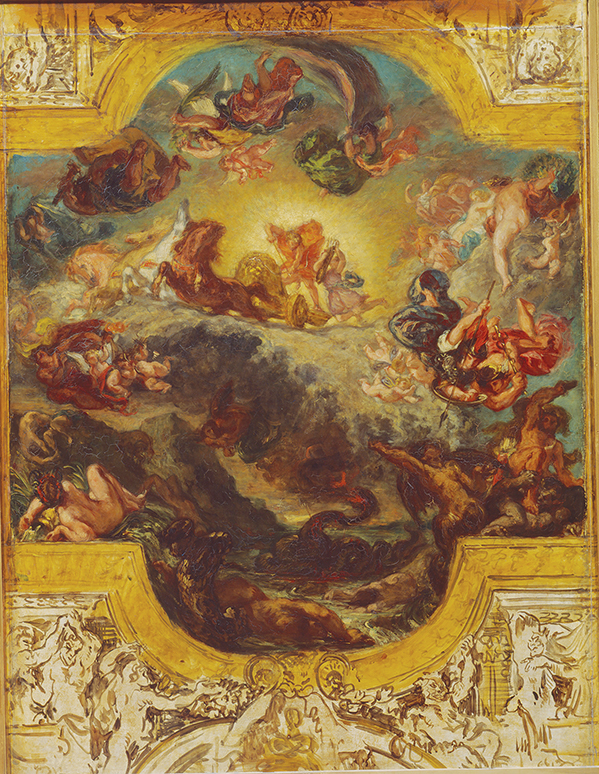
Apollo Victorious over the Serpent Python, sketch, ca. 1850. Oil on canvas. Musées Royaux des Beaux-Arts de Belgique, Brussels. © Royal Museums of Fine Arts of Belgium (RMFAB), Brussels
This is none other than impressionism’s “optical mixture.” So give Delacroix credit for prescience and trailblazing. But it is something of a modern conceit to judge painters of the past as especially great if they presaged modernism. Delacroix was a genius on his own terms. And our own art historical period is not so much the crowning culmination of all that came before, but just another link in a chain.
Columnist John Zeaman is a freelance art critic who writes regularly for The Record and Star Ledger newspapers. His reviews of exhibits in New Jersey have garnered awards from the New Jersey Press Association, the Society of Professional Journalists (New Jersey chapter) and the Manhattan-based Society of Silurians, the nation’s oldest press club. He is the author of Dog Walks Man (Lyons Press, September 2010) about art, landscape and dog walking.

